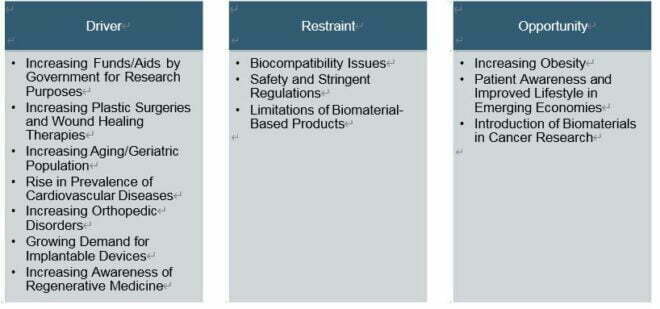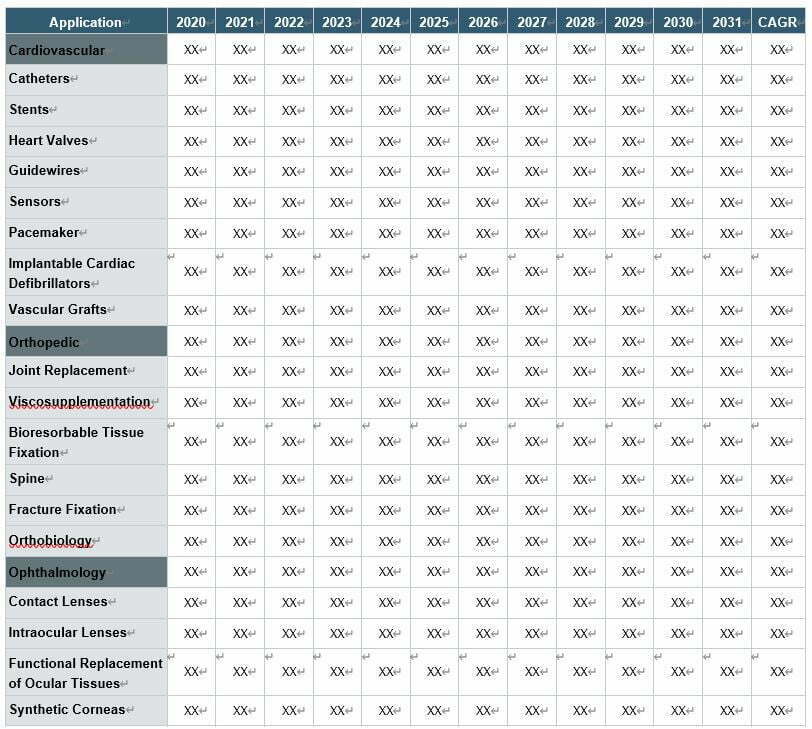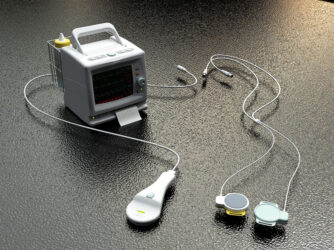Global Biomaterials Industry Outlook and Market Segments
Summary
The biomaterial is a substance that is designed to interact with biological systems for a medical purpose, either a therapeutic (treatment, augmentation, repair, or replacement of tissue function of the body) or a diagnostic one. Biomaterials can be derived from nature or synthesized in the laboratory using a variety of chemical approaches using metal components, polymers, ceramics, or composite materials. They are often used and/or adapted for a medical application and contain a whole or part of a living structure or a biomedical device that leads, increases, or replaces a natural function. Such functions may be relatively passive as used for a heart valve, or perhaps bio actively with interactive functionality, such as hydroxyapatite-coated hip implants. Biomaterials are also used daily in dental applications, operations, and drugs delivery. For example, a construct with impregnated pharmaceutical products may be arranged in the body so that the long-term release of a medicament is possible for a longer period of time. A biomaterial can also be an autograft, allograft, or xenograft used as a transplant material.
In the Middle Ages, the Europeans used sutures made of catgut. Inca surgeons also used golden dishes to repair cranial fractures, and the ancient Maya used shells to create artificial teeth. In 200 AD, Europeans also produced artificial iron teeth. However, these materials were not completely compatible and organic with the human body.
It was only in the last century that the interactions between the body, materials, and plants were examined; they were tested under animals. This has shown the biocompatibility of materials, which was an essential need for materials to be used in the human body. During World War II, an observation was made with the pieces of shattered cockpit canopies that were accidentally embedded in the eyes of pilots but were tolerable. This led to defining the term ‘biocompatibility’ of certain materials, which later led to the creation of an implantable intraocular lens from the same material, which was polymethylmethacrylate (PMMA).
The biomaterials, by type, include biomaterials based on metals, polymers, ceramic, natural, inorganic glass, regenerative, radiopaque, and hybrid-biomaterial combinations of biomaterials. The rapidly growing biomaterials market is driven by several potential applications found in medical applications such as cardiovascular, orthopedic, ophthalmology, tissue engineering, neurological/central nervous system (CNS), dental, plastic surgery, and wound healing.
The major application of biomaterials is cardiovascular, orthopedic, ophthalmology, dental, wound healing, plastic surgery, neurological/central nervous system, tissue engineering among which cardiovascular was the largest application for biomaterials in 2020 in terms of value. The growing use of biomaterials in the cardiovascular application segment is majorly subjected to its biocompatibility as biomaterials come in contact with blood, vascular endothelial cells, fibroblasts, and myocardium, as well as a number of other cells and a cellular matrix material. Biomaterials that are used in the cardiovascular system include materials such as metals and polymers. The use of biomaterials in the cardiovascular system can be classified as temporary internal, temporary external, and permanent internal devices.
In terms of value, the orthopedic is projected to be the second-highest application. The growing use of biomaterials because of their major properties of biomaterials for orthopedic applications include tensile strength, yield strength, elastic modulus, corrosion and fatigue resistance, surface finish, creep, and hardness.
The demand for biomaterials varies according to various regions. The biomaterials market holds a prominent share in various countries of North America, Asia-Pacific and Japan, Europe, the U.K., China, and Rest-of- the-World, among which North America was the largest region for biomaterials in 2020 in terms of value.
Industrial advancements, extensive investments for dedicated R&D facilities, and the development of different application products that require biomaterials are some of the major drivers that are currently propelling the growth of the global biomaterials market in North America. Additionally, due to the wide-scale production of biomaterials as well as technological advancements pertaining to the technology, the global market for biomaterials is expected to grow at a steady rate.
The increasing demand for biomaterials in various applications, such as cardiovascular, orthopedic, ophthalmology, dental, wound healing, plastic surgery, neurological/central nervous system, tissue engineering, has led to a wide acceptance of biomaterials in their procedure over time. This has led to a significant rise in the demand for biomaterials in North America. Additionally, concerted efforts by both the government and the end-user have played a pivotal role in making North America the frontrunner in the field of biomaterials.
Industry Outlook
Trends: Current and Future
As more and more implants have a success rate, the reliability of biomaterials is also improving. In order to further improve the success rate, various biological composite systems are being studied. The unique combination of these biomaterials, their biological surface behavior, and their mechanical substrate properties were studied. Through the interactive mechanism of interface response, a large amount of research and development funds are invested in the accurate prediction and recording of long-term host implantation response. Through these interface reactions, biomechanics, fracture mechanics, fatigue testing, and recovery analysis to establish a long-term relationship with the reliability of biomaterials, it is expected to promote the development of the biomaterials market in the near future. Some of the biomaterials used in this study are bio glass-coated metal and bio glass-coated alumina implants.
In the fields of tissue engineering, trauma, regenerative medicine scaffolds, biosensor nanomaterials, and inorganic nanoparticles customization, tumor resection has become more and more important. The huge challenge in this field is to develop a new platform that integrates biological scaffolds and growth factors or stem cells into biomimetic bone substitutes and uses new technologies to reconstruct large-scale orthopedic defects. The porous biological scaffold has the characteristics of adjustable absorption time, good strength, and good biocompatibility and is mainly used for the future development of tissue engineering treatment. In addition, the use of biological materials in tissue engineering to repair the body’s own tissues and organs will bring a healthy life in the near future. Synthetic and natural biological scaffolds are being developed that provide 3D structures, sufficient mechanical strength, texture, and surface chemistry to support the required cell activity and control bone tissue regeneration. This is an attempt to simulate the microenvironment in the body and study the interaction and behavior of the biomaterial stem cell system.
Research in the cardiovascular field has made great progress. For example, pacemakers are injected with genetically engineered cells to replace pacemaker cells in heart failure. The increasing medical demand has led to the creation and restoration of natural tissues and organs through biomaterials. In dental applications, the further development of biomaterials is mainly due to their biocompatibility in the oral environment. At present, the most widely used dental materials include resin composite materials, titanium alloys, and zirconia.
Market Dynamics
The global biomaterials market is expected to grow at a substantial rate during the forecast period 2021 to 2031. This is due to the superior properties of biomaterials, the growth of end-use industries, the proliferation of application areas, and the emerging economy, all of which have led to a growing demand for increasing for biomaterials. Wide acceptance of biomaterials in cardiovascular, orthopedics, ophthalmology, dental healing, plastic surgery, tissue engineering, nervous/central nervous system, drug delivery systems, urinary applications, and bariatric surgery is due to its biological features and biocompatibility with the body. The factors that contribute to the huge demand for biomaterials are their emerging applications, superior properties, and huge investments by government and federal agencies. Furthermore, the growing awareness of biomaterials in emerging economies such as China, India, or Brazil has fueled the growth of the biomaterials market globally.
Before entering the biomaterials market, the companies need to understand the considerations that eventually go a long way toward ensuring the fulfillment of a company’s efforts to establish itself as a strong player in the market. This section of the report presents an in-depth analysis of the direction toward which the industry is moving and the impact of the various factors on the market. This segment of the report illustrates the factors such as market drivers, market restraints, and market opportunities, listings and analyzes several factors that are positively and negatively affecting the market.

Key Market Development and Strategies
The global demand for biomaterials is attributed to major companies providing solutions for cardiovascular, orthopedic, ophthalmology, dental, wound healing, plastic surgery, neurological/central nervous system, and tissue engineering. This diverse range of business entrants offers possibilities for other players ready to carry the high risks inherent in the industry. This chapter details the latest strategies and technological developments adopted by the key market players in the biomaterials market.
To lead the industry as well as to participate in a phase of market expansion, an organization wants to work in partnership with leading market players, acquire relatively weak firms, add new products and services to the market, and enrich existing products. This chapter details the latest strategies and developments adopted by the key market players in the global biomaterials market. The key players actively taking part in the biomaterials market are BASF SE, Carpenter Technology Corporation, Celanese Corporation, Collagen Solutions Plc, Corbion N.V., Covestro AG, DSM, Evonik Industries, Zimmer Biomet, Wright Medical Group N.V., Mitsubishi Chemical Holdings Corporation., Riton Biomaterial Co., Ltd., Berkeley Advanced Biomaterials Inc., BBS-Bioactive Bone Substitutes Oyj, and Bioretec Ltd.
Application
- Cardiovascular
- Orthopedic
- Ophthalmology
- Dental
- Wound Healing
- Plastic Surgery
- Neurological/Central Nervous System
- Tissue Engineering
- Others
Global Biomaterials Market ( by Application and Sub- Application), $ Billion, 2020 – 2031 (Partial)

To have a full view, please contact us for sample reading. Or buy it online:
Cardiovascular
Cardiovascular application dominates the global biomaterials market. The growing use of biomaterials in the cardiovascular application segment is majorly subjected to its biocompatibility as biomaterials come in contact with blood, vascular endothelial cells, fibroblasts, and myocardium, as well as a number of other cells and a cellular matrix material. Biomaterials that are used in the cardiovascular system include materials such as metals and polymers. The use of biomaterials in the cardiovascular system can be classified as temporary internal, temporary external, and permanent internal devices. The biocompatibility of cardiovascular devices depends on the use method. Temporary external devices include simple tubing, oxygenators, arterial filters, and hemodialysis equipment; temporary internal devices include a wide assortment of catheters used for diagnosis and treatment, guidewire, and cannula for use in bypass circuits. While permanent internal devices are pacemakers, defibrillators, stents, left ventricular assist devices, and artificial hearts.
Catheters
Catheters are medical devices that are inserted into the body in order to treat diseases and perform a surgical procedure. The catheters are either placed in an artery, a vein, or in the urinary tract. Various materials are used in the manufacturing of catheters, namely, silicone rubber, nylon, polyurethane, polyethylene terephthalate (PET), latex, and thermoplastic elastomers, in order to provide excellent geometry, size, mechanical properties, and bio responses.
For instance, polyamide, i.e., nylon, is used to produce percutaneous transluminal coronary angioplasty (PTCA) catheters. Additionally, Covestro AG, a subsidiary of Bayer AG, provides TEXIN RxT85A and RxT90A. Both these products are polyether-based thermoplastic polyurethanes that are aromatic in nature. They offer outstanding abrasion resistance, toughness, flexibility, and impact strength. The medical applications include anesthetic connectors, flexible tubing, films, seals, gaskets, and extruded profiles.
Heart Valves
From the late 1960s, prosthetic heart valves were being used for the treatment of diseased and dysfunctional heart valves. The use of these heart valves has been divided into mechanical heart valves (MHVs) and bio prosthetic heart valves (BHVs). MHVs are made of synthetic materials, namely polymers, metals, and carbon and provide durability. However, due to the thrombogenicity of MHVs, their use is considered unsuitable for patients.
However, the use of BHVs is safe to implant and provides a similar function to the native aortic valve. They do not require long-term anticoagulant therapy and are hence associated with the reduced risk of hemorrhage. The BHVs are mainly derived from human (homograft) or animal (xenograft or heterograft) tissues. In the coming years, it’s expected that BHVs derived from xenograft or heterograft will be extensively used.
Full report:


